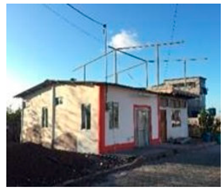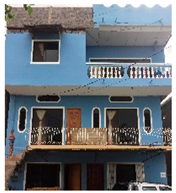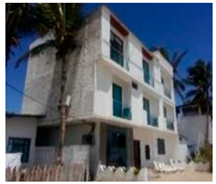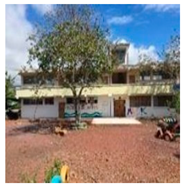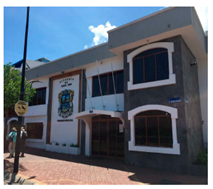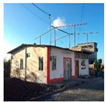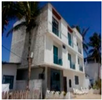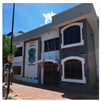Abstract
The Galapagos Islands are undeniably a highly attractive ecosystem for scientists worldwide. However, the energy efficiency and sustainability aspects of their building stock have not yet been studied in depth, which directly hinders the achievement of sustainability goals for the Archipelago, such as reducing resource consumption, minimizing emissions, and improving overall comfort in buildings. Addressing these issues is critical to preserving the islands’ unique ecosystem, as current construction practices are unsustainable and exacerbate environmental pressures, causing over-consumption of local resources and upsetting the delicate ecological balance that sustains this fragile environment. In line with the National Energy Efficiency Plan promoted by the Government of Ecuador for the Archipelago, this study provides transparent and reliable information and data on the building stock of the islands. This work quantifies the impact of buildings on the use of resources and analyses the potential savings of different strategies for reducing greenhouse gas emissions. Various representative typologies are established based on the collection of architectural, construction, and usage information. For each of these typologies, various energy models are developed to establish the baseline and to analyse the demand and comfort of the buildings under different renovation scenarios in order to validate the sustainable construction strategies to be implemented. Moreover, new standards are also defined in order to reduce energy and water consumption and increase indoor air quality and comfort in buildings. In an attempt to generate evidence and facilitate the replication and implementation of sustainable construction standards, three Living Labs (LLs) are created to validate different strategies and technological solutions in different locations, according to the defined standards: a school in Santa Cruz, a hotel in Isabela, and a residential building in San Cristóbal. The findings highlight the effectiveness of specific energy-saving strategies and water conservation measures validated through Living Labs implemented in different locations across the islands. Furthermore, the knowledge generated is transferred through local training of the agents of the construction chain and administration.
1. Introduction
The Galapagos Archipelago is undoubtedly a particularly attractive case study for scientists from all over the world, considered a natural laboratory and the subject of many scientific publications. Its brilliant mosaic of life must be protected, yet several challenges remain on the horizon. Several studies have confirmed and highlighted the increase in energy consumption on the islands [1,2]. This increase can be attributed to several interrelated factors that increase the energy demand of the archipelago. Firstly, population growth on the islands drives an increased need for energy resources to meet the basic needs of residents [3,4]. In addition, the expansion of tourism [3,5], which constitutes a significant part of the island economy and is expected to increase by 3% to 5% annually in the coming years [6], contributes to an increasing energy demand due to the operation of hotel infrastructure, services, and recreational activities.
In conjunction with this increase in energy demand due to population growth and tourism, there is also the impact of climate change. This phenomenon increases the global temperature and, consequently, raises the need for climate control and cooling on the islands. According to Wenz et al. [7], consumption will increase by more than 5% in those countries where the highest consumption in buildings is devoted to meeting cooling demand. Moreover, this increase is higher the warmer the environment is, as in the case study of the Galapagos Archipelago. Moreover, the loss of efficiency in existing equipment and energy systems will also play a crucial role, as obsolete or poorly maintained equipment tend to consume more energy to perform the same tasks compared with more modern and efficient equipment [8,9].
In this context, the residential, commercial, industrial, and hotel sectors on the islands face a growing challenge in managing their energy needs in a sustainable manner. The pressure on these sectors to adopt more efficient and sustainable practices has intensified due to the unique geographical location of the Galapagos Islands, which is characterised by its delicate ecosystem and isolation, which limits the options for importing resources and technology.
Despite these efforts, the lack of detailed research into the energy efficiency and sustainability of the building stock in the Galapagos remains a major gap in the literature. While previous studies have acknowledged the challenges posed by the region’s unique environment, there is a need for further research to identify specific solutions for sustainable building practices that can be applied in this context.
Prior to 2007, the entire energy generation system in the Galapagos Islands was thermal, i.e., based on the use of fossil fuels [10]. The use of fuels as the main source of electricity generation, in addition to endangering the endemic flora and fauna, causes global environmental impacts due to the release of CO2 and other polluting gases. The remote location of islands, together with environmental problems and operational constraints, accentuates the need for innovative strategies and sustainable practices in the building sector to ensure energy consumption that respects and preserves the natural environment and guarantees the comfort of building users. The implementation of energy-efficient and environmentally friendly solutions is therefore vital for the resilience and long-term viability of the Galapagos Islands.
Within this framework, the implementation of energy efficiency and sustainability in the building sector has become a crucial priority. Several initiatives from the Government of Ecuador are promoted to support the transformation of the archipelago into a fair and prosperous society with a modern and competitive economy, such as the “Consultancy for the development of sustainable performance standards for buildings in the Galapagos Archipelago” [6] developed within the strategy proposed for the Galapagos Archipelago in the National Energy Efficiency Plan (PLANEE 2016—2035) [11] and the “zero fossil fuels for Galapagos” initiative [12]. These initiatives sought to promote the development and transfer of environmentally sound technologies to reduce Greenhouse Gas (GHG) emissions and vulnerability to climate change, generating the necessary inputs to set standards for sustainable behaviour of buildings in the Galapagos Archipelago in Ecuador. Buildings in the residential, commercial, and public service sectors were approached through the collection and analysis of available information [13,14].
The primary purpose of this study was to quantify the impact of buildings’ energy consumption and propose and validate strategies to reduce resource use and emissions while improving comfort. The methodology involved a combination of field data collection, energy modelling, and the development of sustainable construction standards, which were then validated through Living Labs in representative buildings on the islands.
By applying this methodology, the study identified significant potential for reducing energy and water consumption in buildings through targeted interventions. Furthermore, the results highlight the importance of adapting construction strategies to the specific environmental and logistical challenges of the islands.
Further research is needed in order to develop innovative solutions that not only reduce the energy demand of the buildings but also pave the way for replication and implementation of sustainable construction standards in the Galapagos, changing the paradigm from conventional to sustainable construction. In this context, the follow-up project “Living Lab for sustainable construction” [15] was approved under the Euroclima + Programme and funded by the French Development Agency to further develop the main outcomes of the previous initiatives.
In this paper, the authors map the implementation process of this project and summarise the main results. The objectives of the study are (i) the implementation of three initiatives for the application of participatory public policy mechanisms through living laboratories, (ii) the generation of local capacities for sustainable buildings, and (iii) the development of appropriate technological tools for sustainable buildings.
This work made it possible to quantify the magnitude of the problem, establishing a baseline on which to validate sustainable construction strategies to be implemented and to assess their impact. This served as a starting point for the development of three “experiential laboratories” where, in addition to validating the different strategies and technological solutions, a transfer of the knowledge generated was carried out through the training of local agents in the construction chain and administration.
2. Methodology
Figure 1 presents a graphical summary of the methodology applied in this study. For the initial definition of the sustainable building standards, two parallel paths were followed, which continuously fed back into each other: (i) an approach based on the analysis of data and information, with a comprehensive background check, extensive and targeted data collection, and energy simulations of representative buildings where the challenge and the impact of the proposals were quantified and assessed; (ii) an approach based on co-creation and co-monitoring, including workshops and focus groups. The results obtained were validated with the key actors, and their considerations were collected.
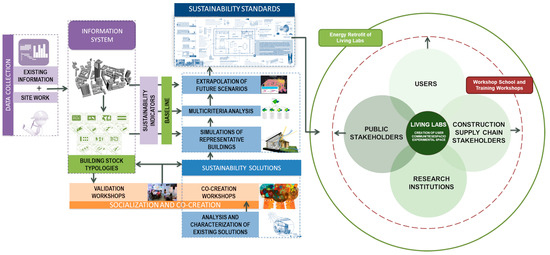
Figure 1.
Graphical summary of the methodology applied in this study.
The methodology for the second part of the study is based on the philosophy of Living Labs [16,17]. This new concept of LL seeks to promote innovative processes where users become active actors and not just passive recipients, considering the relationship among the parties involved in order to bring together the four helixes of society: users, public actors, private actors, and knowledge institutes. LLs have been used in the past to facilitate the implementation of innovative building technologies [18] as genuine test beds to respond to the needs previously identified in the sustainable building standards through data collection and surveys [19,20,21]. In addition, they have also been applied to the development of an ecosystem for the detection of barriers and opportunities in the field of energy in buildings [22] or the application of sustainable building standards. All of this makes it a cooperative and consensual process that fits the needs of the present study.
2.1. Data Collection
The first step in the overall process is to collect data on two spheres: (i) criteria, objectives, and framework of indicators to guide decision-making and to validate the results obtained; (ii) building characteristics. Regarding the second sphere, information was collected on the architecture and construction of a total of 911 buildings: 345 in Santa Cruz, 313 in San Cristóbal, and 253 in Isabela. Furthermore, 407 surveys on conditions of use and comfort within the buildings were carried out, distributed as follows: 142 in Santa Cruz, 134 in San Cristóbal, and 131 in Isabela. This made it possible to establish the 22 predominant building typologies on the three islands.
2.2. Establishment of the Baseline
In order to obtain a parametric characterisation of the energy efficiency of representative building typologies, both energy demand and consumption and comfort conditions were analysed for the main typologies identified in the previous step. During the workshops, representative buildings in each of the predominant typologies were selected. From these, 22 energy models were generated for assessment, with each model corresponding to one of the typologies obtained from the data collection. The dynamic energy simulations of these models, with an hourly frequency, were performed using the EnergyPlus calculation engine [23], with the DesignBuilder software (version 4.7.0.027) [24] as the graphic interface. The models considered the meteorological conditions of the Galapagos, the volumetry and construction characteristics of the buildings, and the usage profiles obtained through the surveys carried out.
Using the energy models developed, the main problems with the building constructions on the islands were identified. In addition, the baseline consumption was established based on an analysis of the different types of energy consumption and GHG emissions. These analyses made it possible to determine the opportunities for improvement for each type of building. To verify the accuracy and validity of the energy models, the results were compared with real consumption data obtained from energy bills.
2.3. Impact Assessment of Strategies
In the next stage, different packages of interventions and strategies were designed to improve the energy performance of the archipelago’s building stock. The energy models developed in the previous stage allowed us to assess the potential impact of each of the strategies, individually and as a whole. This evaluation was performed from the energy point of view, both demand and consumption, user comfort, and CO2 emissions. With the results of these two stages (baseline and impact assessment), likely scenarios of future demands and emissions of Galapagos buildings were obtained through seasonal average yields and energy-to-CO2 emission ratios. It was proven that at all levels of implementation of the energy measures, considerable energy savings and a reduction in CO2 emissions were achieved. This facilitated the achievement of the objectives set out in the PLANEE for the Galapagos Axis. In addition, the impact of the implementation of these interventions on other indicators, such as water demand, was verified.
2.4. Definition of Sustainability Solutions
After verifying the impact of the application of the defined sustainable construction strategies and interventions, the suitability of each building typology was analysed. This was conducted based on an analysis of the impact produced by the application of each of the strategies on the different typologies, focused on the following aspects: energy savings, reduction of CO2 emissions, improvement of comfort, visual impact, and cost of implementation. In addition, the following were identified for each of the strategies or actions: (i) the building typologies on which it should be implemented, i.e., new construction and/or rehabilitation; (ii) characteristics, functionalities, and objectives of improvement of its application; (iii) schemes and sketches showing the concepts and effects of its application; (iv) materials and elements necessary for its implementation; (v) advantages and disadvantages of its application; (vi) aspects to take into account when implementing it; and (vii) aspects of the sustainability of its implementation.
The Living Lab’s own ecosystem favoured the participation of local actors, and the input obtained from the individualised interviews and workshops contributed to (i) validation and completion of the representative building typologies, (ii) evaluation and prioritisation of the different criteria to be applied, (iii) evaluation of the acceptability of the strategies (iv) definition of the content of the standards, and (v) establishment of a roadmap for the subsequent implementation of the standards.
2.5. Deployment of Living Labs
Finally, once the sustainable construction standards for the Galapagos Archipelago were defined, three LLs were developed. The objective of the 3 LLs was to generate evidence to facilitate the replication and implementation of the standards and the transfer of knowledge generated through local training. In addition, regulatory and institutional strengthening instruments that guarantee the implementation of the new standards towards sustainable buildings and energy efficiency were also generated.
As a complement to the LL ecosystem, training and knowledge transfer to both public and private sector actors in the construction chain was carried out. In addition, to facilitate replication, plans were made to compile, disseminate, and replicate the experience of generating public policies based on Living Labs. This will position Galapagos nationally and internationally as a social laboratory and as a benchmark for climate change mitigation actions.
To achieve these objectives, a Living Labs School/Workshop was developed, aimed at local administration staff and agents in the construction chain. Here, a playful, experiential form of education was proposed in which participants take an active role in the learning process, applying gamification techniques that promote critical thinking in the group and empower them to action. This teaching–learning approach promotes a balance between affective (emotional), behavioural, and cognitive (knowledge-based) learning. Furthermore, learning is inductive, which means that participants come to their own conclusions about the experience and content of the Living Labs, making it easier for them to directly apply their learning to real-world situations and thus facilitating replication. To this end, the ERCA technique [25] (experience, reflection, conceptualisation, and application; represented in Figure 2) is applied, where these four stages are present in the design and deployment of the workshop and training school to complete the learning cycle within the Living Labs ecosystem of sustainable building.
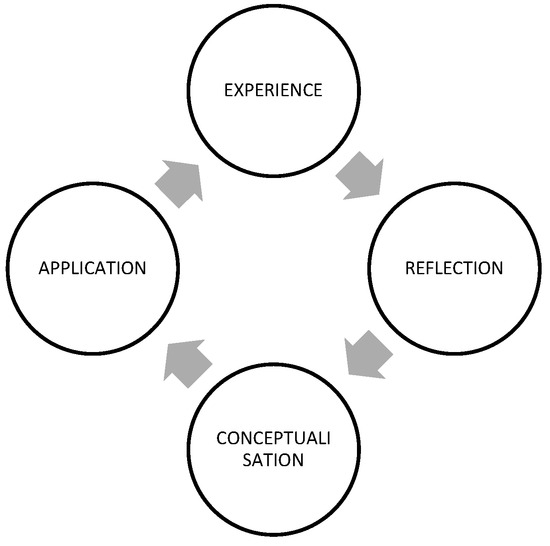
Figure 2.
ERCA learning methodology [25].
Focusing on the objectives of the Living Labs, participatory work with all involved stakeholders was proposed. This collaborative approach was key in the formulation and approval of architectural designs. These designs incorporated strategies and solutions that were tested in demonstrative rehabilitation projects. Once the renovation designs were defined, a preliminary analysis of the effectiveness and determination of the impact of the solutions proposed in the intervention of each of the Living Labs was carried out.
A system of indicators was defined as the starting point to validate the designs and interventions implemented in the rehabilitation of the three Living Labs. This system enabled both monitoring and assessment of the impact of the proposed sustainability strategies. It was agreed that the framework of indicators for evaluating the Living Labs be structured across three areas: energy, social, and environmental. These areas address the various challenges that sustainable building standards must meet, although this framework of indicators was reviewed at the project’s conclusion based on analysis of the data collected during the monitoring phase following completion of the three Living Labs’ rehabilitations.
The defined indicators on which the results were evaluated are listed in Table 1:

Table 1.
List of indicators.
Finally, once the initial rehabilitation designs for the Living Labs were defined using sustainable building standards, indicators were established to assess their effectiveness. A bioclimatic analysis was then conducted, as observed in Figure 3 and Figure 4, identifying optimal strategies for buildings in the Galápagos Islands. Additionally, energy models were developed for each of the three Living Labs (Figure 5, Figure 6 and Figure 7). These analyses form the basis for simulating rehabilitation scenarios. They also allow for impact quantification, which serves to validate the preliminary designs.
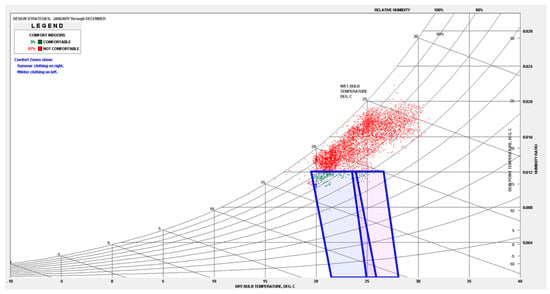
Figure 3.
Annual comfort according to ASHRAE Standard 55 without the strategies.
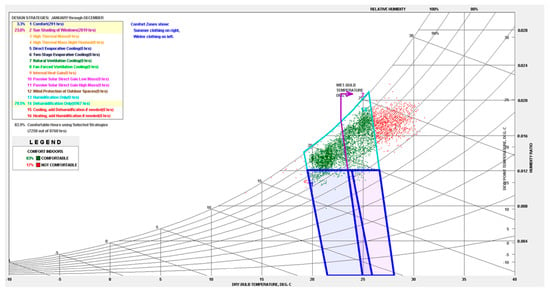
Figure 4.
Annual comfort according to ASHRAE Standard 55 with applied comfort strategies.

Figure 5.
Energy model for calculating the baseline and the rehabilitation model of the residential Living Lab.

Figure 6.
Energy model for calculating the baseline and the rehabilitation model of the school Living Lab.

Figure 7.
Energy model for calculating the baseline and the rehabilitation model of the hotel Living Lab.
3. Results
3.1. Challenges of Construction in the Galápagos Archipelago
The information gathered from the architectural and construction survey of the built environment was invaluable. It, along with the results of the energy simulations of identified representative buildings, allowed for the identification of the main weaknesses in each construction typology. Additionally, it confirmed the issues faced by buildings on the islands. These issues hinder users from achieving optimal comfort conditions indoors.
The typological study of the built environment enabled the classification of island buildings into five basic archetypes. These archetypes are based on common characteristics that define them: (i) residential villa-type houses, (ii) residential apartment buildings, (iii) hotels, (iv) educational centres, and (v) public office buildings.
The Table 2 presents the construction characteristics associated with the defined archetypes for each building typology analysed in the built environment.

Table 2.
Summary of construction characteristics of defined archetypes.
The greatest issue experienced by users inside buildings is high temperatures caused by radiation impacting the building envelope. This results in decreased comfort levels. Moreover, in cases where air conditioning systems are available to meet this demand, energy consumption increases due to the use of cooling appliances to counteract the high temperatures. The main challenges and elements that sustainable building standards should focus on are as follows:
- Improvement of the Roof
Buildings on the islands generally have metal or fibreglass cement roofs. Only in the case of flat roofs is concrete used. Additionally, the roofs lack an under-roof or a ventilated covering, placing them in direct contact with occupied areas. As a result, the heating caused by solar radiation on the roof is transferred directly indoors. This increases interior temperatures, decreases comfort levels, and raises the demand for cooling systems. The islands’ location exposes buildings to significant solar radiation. The roof is the primary source of heat gain inside the buildings. It is estimated that around 46% of total heat gains occur through this construction element.
- Protection of Openings
As mentioned, the islands’ location means that solar radiation greatly impacts the interior conditions of buildings. Consequently, a significant portion of their heat gains results from solar radiation entering through the glazed envelope. The results of the analysis revealed that most buildings on the islands have metal frames without thermal breaks and single glazing and have no shading elements. This type of framing and the absence of shading systems allow direct radiation to penetrate the windows and transfer heat indoors. This type of glazed envelope is one of the main sources of heat gains, accounting for approximately 26% of total gains.
- Improvement of the Opaque Envelope
Buildings on the islands are constructed using concrete blocks. Generally, only the main façades have a white lime finish or a light tone, while the concrete block is left exposed in other areas. This type of enclosure presents two significant issues regarding the building’s energy performance in the warm climate of the Galápagos Islands. First, it has very low thermal resistance, which facilitates heat transfer into the building during the day. Second, it has high thermal inertia, meaning the façades store heat during the day and transfer it indoors at night. This problem worsens when enclosures lack mortar finishing, allowing concrete blocks to absorb more solar radiation and increasing heat transfer indoors. This type of opaque envelope exhibits low thermal resistance and high thermal inertia, resulting in heat gains both day and night. Simulation results show that approximately 16% of total heat gains occur through the opaque envelope.
- Optimisation of Final Energy Uses
Data collection showed that very few residential buildings have air-conditioning systems and that, in those dwellings that do, energy consumption is high. This is due to two factors: (i) the high demand for air-conditioning arises from the construction deficiencies mentioned earlier, leading to elevated electricity consumption if an air-conditioning system is used, and (ii) due to the low efficiency of the equipment. In the commercial sector, the majority of electricity consumption is used for air-conditioning. This ranges from 40% of final energy consumption in Santa Cruz to 72% of total energy consumption in San Cristóbal [26]. As far as lighting is concerned, due to the hours of use of lighting (in all cases less than 6 h/day) and the programmes to change luminaires that have been carried out in recent years [27], which have led to 100% of the buildings having low consumption luminaires, electricity consumption is low. These luminaire replacement programmes can be seen as a clear example of what can be achieved through the development of the Living Labs for sustainable buildings. Education, co-decision, and ease of access to this equipment have been key to effective and massive change.
3.2. Sustainable Building Standards
The simulations conducted for the 22 representative buildings within these five major archetypes enabled the definition of sustainability strategies for each of the analysed sectors. This addressed the energy, social, environmental, and economic challenges faced by construction in the Galapagos.
The strategies and measures included in the sustainability standards focus on (i) reducing the consumption of non-renewable energy, (ii) improving comfort and citizen acceptance of measures, (iii) reducing the environmental impact of buildings, and (iv) minimising the economic impact of solutions. Therefore, when determining the sustainable construction strategies to apply to each archetype, four fundamental aspects were considered: (i) the specific characteristics of the buildings in the archipelago; (ii) climatic, landscape, environmental, and geographical conditions (including the additional difficulties posed by insularity and environmental protection policies regarding the procurement of materials and equipment); (iii) the conclusions from socialisation workshops with local stakeholders; and (iv) the construction and formal characteristics of each building typology, along with their energy situation.
To facilitate the implementation of the defined strategies and solutions, three levels of intervention (basic, medium, and advanced) were established for each building typology. These levels consider different objectives for energy improvement and comfort, socioeconomic circumstances, investment capacity, and the availability of governmental aid or incentives, among other factors. The following matrix (Table 3) provides a description of rehabilitation and new construction interventions, suggesting appropriate actions for each building typology.

Table 3.
Matrix of intervention strategies and energy efficiency measures on the defined building typologies.
The majority of the interventions defined at different levels, in line with the project’s initial hypothesis, were based on passive and easily implementable strategies. These interventions aimed to address one of the primary issues identified in building construction in the Galapagos: the lack of quality in the thermal and structural envelope of buildings. As noted previously, in addition to defining a set of measures based on the intended improvement goal, the impact of each measure’s independent application was also analysed. This analysis confirmed that the most impactful measures were those that addressed the deficiencies outlined in Section 3.1 of this article.
The measure that achieved the greatest overall impact is the implementation of a ventilated under-roof (Figure 8). This solution, which can be easily applied to any building with a sloped roof, provided the best results across all building types.

Figure 8.
Impact of the ventilated under-roof.
Other measures that yielded better results through interventions in the opaque envelope included the use of light-coloured finishes with a high reflectance index on the roof and facade (Figure 9). As a logical next step in improving any building’s envelope, applying thermal insulation to the envelope was also recommended (Figure 10).
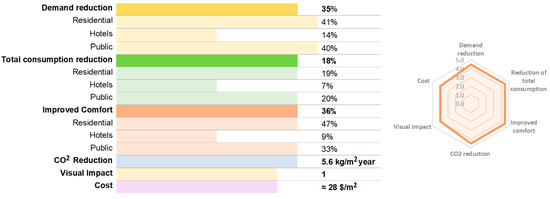
Figure 9.
Impact of light-coloured finishes with high reflectance index.

Figure 10.
Impact of applying thermal insulation on roof and facades.
Among the strategies for minimizing heat gain through glazed envelopes, the use of solar control films and shading through vegetation on windows were the most impactful measures across all building types (Figure 11 and Figure 12). Both measures provided the best cost-effectiveness in reducing demand and enhancing interior comfort. Additionally, using vegetation as a shading element offers further social, environmental, and visual co-benefits associated with natural solutions.
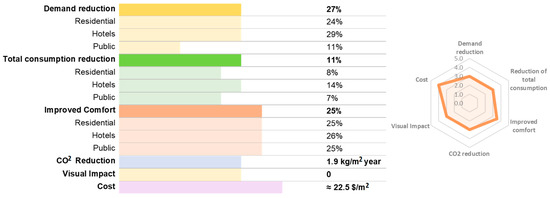
Figure 11.
Impact of applying solar control films.
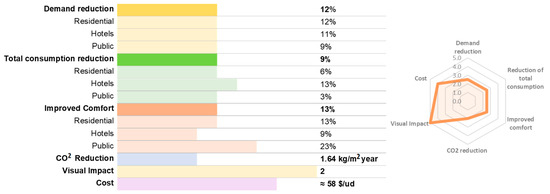
Figure 12.
Impact of using vegetation as a shading element.
The information gathered through the collection of construction data and the representativeness of each identified building typology, along with the development of energy simulations, served to establish the baseline for building-level indicators. By understanding the representativeness of each of the 22 identified building typologies, it was possible to extrapolate the baseline results to a baseline at the parish (the smallest administrative division in Ecuador) and island levels. Using these data and estimating a series of future scenarios—considering variables such as growth trends (population and tourism), climate change projections (temperature increases), and shifts in energy use due to equipment obsolescence—the impact of implementing strategies on the islands’ buildings was estimated.
This process enabled the validation of sustainable building standards with solutions aligned to meet the sustainability goals set by PLANEE for the Galapagos axis, specifically the reduction of cumulative fossil energy consumption in the Galapagos Islands by 0.36 Mtoe. Implementing these measures in a portion of the building stock is projected to achieve 22% of the target.
3.3. Development of the Living Labs
Both construction sector stakeholders and government officials were successfully engaged as a result of the open innovation approach of the Living Labs. The project involved them in a cooperative and consensual process in the development and application of sustainable construction standards in the island’s buildings. This methodology addressed the specific needs of the island’s users/residents, who consistently provided feedback to ensure that the outcomes were evaluated and evolved appropriately toward the optimal version in each case.
Throughout various workshops, meetings, and focus groups held within the framework of the sustainable building training school, results were cross-referenced with public administration personnel and stakeholders involved in the construction phase. This was carried out across each of the three islands using the Living Labs ecosystem. This process transformed quantitative results into qualitative insights by engaging the four main stakeholders in the Living Labs: (i) public actors, (ii) private actors, (iii) knowledge institutions, and (iv) end-users from the pilot rehabilitation case. This approach actively enabled the definition of user requirements based on their personal knowledge and experiences in prior cases.
As a preliminary step to evaluate the measures and designs proposed by the various stakeholders, quantification and assessment of different representative comfort and energy consumption parameters and indicators were conducted based on the baseline model as shown in Table 4. This was achieved using energy models developed for each of the three Living Labs. The defined indicators were later used in new simulations to quantify the impact of the strategies applied in each Living Lab:

Table 4.
Calculation of baseline indicators.
The measures proposed in the Living Labs interventions consisted of the following: (i) implementing shading elements and roof insulation to minimize heat gains, (ii) improving natural ventilation by modifying geometry, (iii) installing vents or opening spaces to enhance cooling, and (iv) installing renewable energy generation systems.
For the hotel, the availability of vacant rooms on each floor was leveraged to design a system that creates airflow within a duct running through the hotel corridor’s false ceiling (Figure 13). This system, with vents connecting the hotel rooms to the corridor, was intended to enhance natural ventilation in each area.
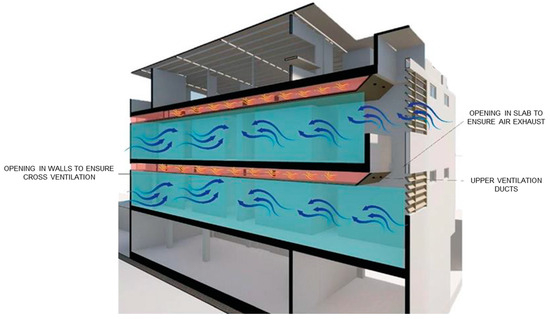
Figure 13.
Proposed scheme for improving natural ventilation in the hotel.
Figure 14 compares the comfort levels of three different cases for the hotel LL where E01 is the baseline case, E02 is the intervention case with natural ventilation through windows, and E03 is the intervention case with natural ventilation through windows with rooms connected to the corridor. The results show that the proposed ventilation solution outperforms the thermal comfort levels of the first intervention option, considerably improving the comfort levels of the base case.

Figure 14.
Comparison of thermal comfort levels for the hotel LL.
The roof geometry was modified in the residential building and school Living Labs. Openings and ventilation grilles were installed on opposite sides of the building at different heights to enhance interior cooling (Figure 15). This design allows air entering through the windows to exit through the openings under the roof, drawing out the warm air that typically accumulates in the upper parts of the spaces.
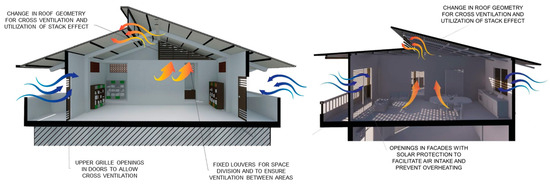
Figure 15.
Sectional view of the proposed improvement of natural ventilation in the school and the residential building.
Table 5, Table 6 and Table 7 show the results of the proposed measures in each of the Living Lab interventions, where PPD represents the Percentage of People Dissatisfied according to Fanger’s method [28], and T° denotes the average interior temperature of the different thermal zones: Cool. indicates the total cooling demand and % Reduction shows the percentage decrease in cooling demand after the intervention.

Table 5.
Intervention results for residential building LL.

Table 6.
Intervention results for school LL.

Table 7.
Intervention results for hotel LL.
Finally, after validation of the strategies identified through energy simulations and the generation of evidence to facilitate replicating sustainable building standards, the final designs and rehabilitation projects for the three Living Labs were defined. Figure 16, Figure 17 and Figure 18 show the final designs implemented. These designs also served as training models for stakeholders in the construction chain during project execution.
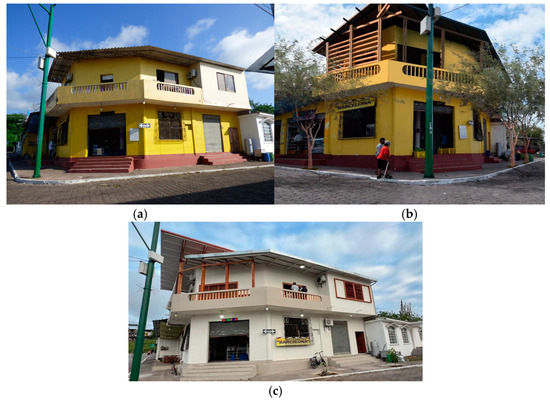
Figure 16.
(a) Original state, (b) retrofit design, and (c) final result after the retrofit of the residential Living Lab.
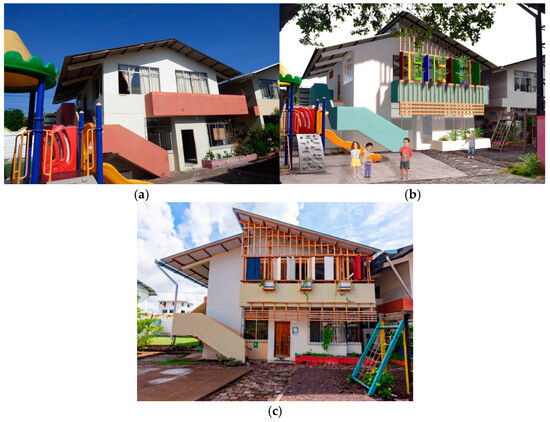
Figure 17.
(a) Original state, (b) retrofit design, and (c) final result after the retrofit of the school Living Lab.
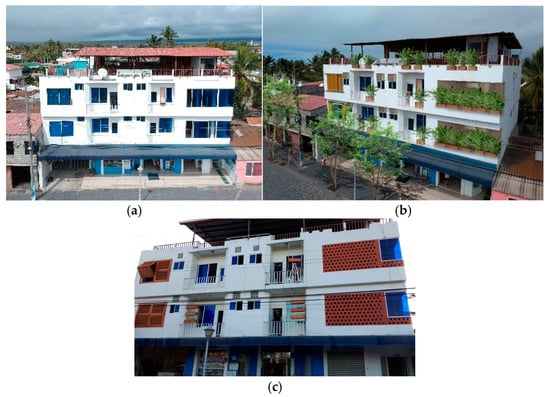
Figure 18.
(a) Original state, (b) retrofit design, and (c) final result after the retrofit of the hotel Living Lab.
Finally, it is important to note that the ecosystem created within the Living Labs not only served to validate the implementation of strategies in the three real buildings but also facilitated a continuous learning process from day one of the project to replicate the generated knowledge. Therefore, participatory work was conducted with stakeholders in the construction chain to formulate architectural designs for the rehabilitations, which incorporated measures outlined in the sustainable building standards. Additionally, collaboration with public agents led to the development of public policies focused on sustainable buildings, emphasising energy efficiency and proper water use. This effort resulted in the creation of three ordinances with guidelines and standards for transitioning toward buildings that integrate criteria for energy and water efficiency in each of the three cantons: Santa Cruz, San Cristóbal, and Isabela.
This initiative provided the knowledge necessary to implement the proposed strategies and actions outlined in the sustainable building standards; thus, it contributed to the development of a specialised construction service capable of conceiving, designing, and constructing liveable spaces in the Galapagos Islands. These spaces will incorporate aspects such as energy efficiency and appropriate water use while enhancing user comfort. In addition, it trained construction chain actors as agents of change toward the sustainable building paradigm.
4. Conclusions
The characteristics of the Galapagos Islands’ environment and the accessibility and availability of certain materials or equipment are key factors in determining the viability of using specific construction solutions in protected and vulnerable areas. This represents a limitation when applying the passive strategies and measures that are essential for achieving comfort sustainably. With this in mind, all sustainability measures affecting the building’s envelope were designed and validated with local stakeholders, considering the sustainability of the Galapagos environment. Therefore, the present study worked to minimise any negative environmental or visual impact on the surroundings when applying the defined sustainable building standards; in fact, its impact was the opposite, as the implementation of these measures enabled many existing buildings in the islands to reduce energy consumption and water usage while enhancing interior comfort. These improvements also brought about a visual enhancement, presenting a more coherent appearance aligned with the unique Galapagos environment.
Additionally, it was identified that water management and conservation offer significant potential for improvement. This is partly due to the lack of water meters to measure consumption in rural areas and the absence of billing based on actual usage, which can encourage wasteful water practices by building occupants. Although there are no meters in the buildings to quantify the savings, it can be concluded that applying the water-saving measures included in the standards, primarily the installation of aerators on faucets and the use of dual-flush toilets, would lead to a considerable reduction in water consumption across the islands.
The results herein presented will facilitate the development and implementation of plans to improve energy efficiency in the buildings of the archipelago. Furthermore, they will support compliance with the objectives of the PLANEE, enabling progress toward the goals outlined within it. The insights gained from validating the standards and sustainable building ordinances can also enrich and enhance the characteristics outlined in the Ecuadorian Construction Standard (NEC) regarding the materials and strategies that must be implemented to achieve the defined objectives. This will contribute to the development of specific interventions and solutions for sustainable building design in the islands.
In addition, these results will serve as a basis for future research in the field of sustainable architecture and energy efficiency in ecologically sensitive areas, which could facilitate replication in other regions facing similar environmental challenges.
Successful implementation of the proposed sustainable building standards will have a cascading effect, encouraging the adoption of sustainable practices not only in the construction sector but also in various industries in Galapagos. This approach and methodology will serve as a model for other protected areas around the world, showing the potential for balancing development with ecological preservation.
A key limitation of this study is the lack of long-term, real-world performance data on the sustainable building standards implemented. Future research should address this gap by conducting post-implementation monitoring to assess the ongoing effectiveness of these strategies, particularly regarding energy and water savings.
Additionally, future studies should investigate the broader social and economic implications of these interventions, including local acceptance and behavioural changes, which could influence the long-term success of sustainable building practices in the Galapagos Archipelago.
Finally, the authors believe that the results of this project can also complement the “Practical Guide for Efficient Use of Electric Energy in Ecuador” by incorporating new energy-efficiency strategies detailed in the standards and validated in the Living Labs.
Only a systemic change in the construction sector of the archipelago, which addresses the issues comprehensively, will achieve a sustainable future for building in the Galapagos. This systemic change should propose solutions not only of a technical nature, as outlined in the standards, or legislative measures, as included in the ordinances, but also logistical, financial, economic, training, and awareness-raising initiatives. These efforts will serve to promote, conserve, and strengthen the environmental and territorial sustainability of the islands while socioeconomically activating the territory and protecting the unique enclave that is the Galapagos.
Author Contributions
Conceptualization, J.T.-B., I.L.-V. and A.E.; methodology, J.T.-B., I.L.-V., A.E., A.G.-M. and A.R.-A.; validation, J.T.-B., A.R.-A. and Z.E.; formal analysis, A.G.-M. and Z.E.; investigation, J.T.-B., I.L.-V., A.E., A.G.-M. and A.R.-A.; writing original draft preparation, J.T.-B., I.L.-V., A.E. and A.G.-M.; writing review and editing, J.T.-B., I.L.-V., A.E., A.G.-M., A.R.-A. and Z.E. All authors have read and agreed to the published version of the manuscript.
Funding
This research did not receive any specific funding from public, commercial, or non-profit sectors.
Data Availability Statement
The original contributions presented in the study are included in the article, further inquiries can be directed to the corresponding authors.
Conflicts of Interest
The authors declare no conflicts of interest.
References
- Ricaurte, K.P.R. Diseño de un Microgrid en el Parque Nacional Galápagos San Cristóbal Pto. Baquerizo Moreno. Bachelor’s Thesis, Universidad de las Américas, Quito, Ecuador, 2019. [Google Scholar]
- Instituto de Investigación Geológico y Energético (IIGE). Balance Energético de la Provincia de Galápagos 2018. 2018. Available online: https://www.geoenergia.gob.ec/wp-content/uploads/downloads/2020/05/balance_energetico_de_galapagos_2018.pdf (accessed on 1 September 2024).
- Instituto Nacional de Estadística y Censos-INEC. Análisis de Resultados Definitivos Censo de Población y Vivienda Galápagos 2015. 2015. Available online: https://www.ecuadorencifras.gob.ec/documentos/web-inec/Poblacion_y_Demografia/CPV_Galapagos_2015/Analisis_Galapagos%202015.pdf (accessed on 1 April 2024).
- Consejo de Gobierno del Régimen Especial de Galápagos. Plan Galápagos-Plan de Desarrollo Sustentable y Ordenamiento Territorial. 2015. Available online: https://www.gobiernogalapagos.gob.ec/wp-content/uploads/downloads/2017/04/Plan-Galapagos-2015-2020_12.pdf (accessed on 1 September 2024).
- Consejo de Gobierno del Régimen Especial de Galápagos. Informe Técnico Respecto a la Distribución y Actualización de la Tasa de Ingreso por Conservación de Áreas Naturales Protegidas. 2023. Available online: https://www.gobiernogalapagos.gob.ec/wp-content/uploads/downloads/2024/03/c.2.-informe_tecnico_st_-_aprobado_por_ctpt.pdf (accessed on 1 September 2024).
- Tecnalia. Consultoría para el Levantamiento y Desarrollo de Estándares de Comportamiento Sostenible de Edificaciones del Archipiélago de Galápagos—Resumen Ejecutivo. Available online: https://fundacionbariloche.org.ar/wp-content/uploads/2019/04/5.-Resumen-Ejecutivo-Est%C3%A1ndares-Sostenibilidad-Edificaciones-Gal%C3%A1pagos.pdf (accessed on 1 September 2024).
- Wenz, L.; Levermann, A.; Auffhammer, M. North–south polarization of European electricity consumption under future warming. Proc. Natl. Acad. Sci. USA 2017, 114, E7910–E7918. [Google Scholar] [CrossRef] [PubMed]
- Ministerio de Electricidad y Energía Renovable, Ecuador. Guía Práctica para el uso Eficiente de la Energía Eléctrica en el Ecuador. 2015. Available online: https://www.ambiente.gob.ec/wp-content/uploads/downloads/2014/03/GUIA-PRACTICA-PARA-EL-AHORRO-Y-USO-EFICIENTE-DE-ENERGIA-22NovBAJAa.pdf (accessed on 1 April 2024).
- Instituto. Guía Práctica de la Energía. Consumo Eficiente y. 2004. Available online: https://www.idae.es/uploads/documentos/documentos_11406_Guia_Practica_Energia_3ed_A2010_509f8287.pdf (accessed on 1 March 2024).
- Ayala-Pico, J.; Arcos-Aviles, D.; Ibarra, A.; Fernandez, C.; Guinjoan, F.; Martinez, W. Current development of electricity generation systems in the Galapagos Islands–Ecuador. Renew. Energy Focus 2023, 46, 88–102. [Google Scholar] [CrossRef]
- Ministerio de Electricidad y Energía Renovable del Ecuador. Plan Nacional de Eficiencia Energética 2016–2035 (PLANEE); Ministerio de Electricidad y Energía Renovable del Ecuador: Quito, Ecuador, 2016. [Google Scholar]
- Ministerio de Electricidad y Energía Renovable del Ecuador. Cero Combustibles Fósiles para Galápagos; Ministerio de Electricidad y Energía Renovable del Ecuador: Quito, Ecuador, 2008. [Google Scholar]
- Egusquiza, A.; Torres, J.; Alzola, M.; Cortés, A.; Mejía, E. Levantamiento y desarrollo de Estándares de comportamiento sostenible de edificaciones del Archipiélago de Galápagos. In Memorias del Congreso Internacional I+ D+ i-Sostenibilidad Energética; Instituto de Investigación Geológico y Energético: Quito, Ecuador, 2019; Volume 1, pp. 21–41. Available online: https://geolatitud.geoenergia.gob.ec/ojs/ojs/index.php/congreso-idi/article/download/77/43 (accessed on 1 March 2024).
- Torres, J.; Egusquiza, A.; Garrido-Marijuan, A.; Lopez, I.; Romero-Amorrortu, A.; Villaverde, A.; Granda, M. Implementación de estándares de construcción sostenible en edificaciones del archipiélago de islas Galápagos. In REHABEND 2024; University of Cantabria—Building Technology R&D Group: Gijon, Spain, 2024. [Google Scholar]
- Union Europea-Euroclima. “Living Lab de Edificación Sostenible” Implementado en el Archipiélago de GALÁPAGOS—ECUADOR. Available online: https://www.euroclima.org/proyectos-energia/living-lab-de-edificacion-sostenible (accessed on 1 September 2024).
- Lasarte, N.; Elguezabal, P.; Sagarna, M.; Leon, I.; Otaduy, J. Challenges for Digitalisation in Building Renovation to Enhance the Efficiency of the Process: A Spanish Case Study. Sustainability 2021, 13, 122139. [Google Scholar] [CrossRef]
- The European Network of Living Labs (ENoLL). What Are Living Labs. Available online: https://enoll.org/about-us/ (accessed on 1 March 2024).
- Ahmed, D. McGough and M. Mateo-Garcia. Testing innovative technologies for retrofitting: Coventry University as a living lab. Entrep. Sustain. Issues 2017, 4, 257–270. [Google Scholar]
- Andersson, S.; Rahe, U. Accelerate innovation towards sustainable living: Exploring the potential of Living Labs in a recently completed case. J. Des. Res. 2017, 15, 234. [Google Scholar] [CrossRef]
- Korsnes, M.; Berker, T.; Woods, R.D. Domestication, acceptance and zero emission ambitions: Insights from a mixed method, experimental research design in a Norwegian Living Lab. Energy Res. Soc. Sci. 2018, 39, 226–233. [Google Scholar] [CrossRef]
- Coleman, S.; Robinson, J. Introducing the qualitative performance gap: Stories about a sustainable building. Build. Res. Inf. 2018, 46, 485–500. [Google Scholar] [CrossRef]
- de Agustín-Camacho, P.; Romero-Amorrortu, A.; Krysinski, D. A new era in the energy performance of buildings. EU Res. Mag. 2017, 2017, 42–43. [Google Scholar]
- Available online: https://energyplus.net/ (accessed on 1 September 2024).
- Available online: https://designbuilder.co.uk/ (accessed on 1 September 2024).
- Defaz, M. Metodologías activas en el proceso enseñanza—Aprendizaje. Roca Rev. Científico—Educ. Prov. Granma 2020, 16, 463–472. [Google Scholar]
- Ministerio de Electricidad y Energía Renovable (MEER). Informe Usos Finales Galápagos Realizado “Levantamiento de Información Base para la Realización del Estudio de Demanda y usos Finales de Energía en el Sector Residencial, Comercial (Hoteles) y Servicios en la Provincia de Galápagos”. Available online: http://historico.energia.gob.ec/biblioteca (accessed on 1 September 2024).
- Ministerio de Energía y Recursos Naturales no Renovables (MERNNR). Programa de recambio de equipos de mayor consumo energético por equipos etiquetados de menor consumo.
- Fanger, P.O. Thermal Comfort: Analysis and Applications in Environmental Engineering; McGraw Hill Book Company: New York, NY, USA, 1970. [Google Scholar]
Disclaimer/Publisher’s Note: The statements, opinions and data contained in all publications are solely those of the individual author(s) and contributor(s) and not of MDPI and/or the editor(s). MDPI and/or the editor(s) disclaim responsibility for any injury to people or property resulting from any ideas, methods, instructions or products referred to in the content. |
© 2025 by the authors. Licensee MDPI, Basel, Switzerland. This article is an open access article distributed under the terms and conditions of the Creative Commons Attribution (CC BY) license (https://creativecommons.org/licenses/by/4.0/).
